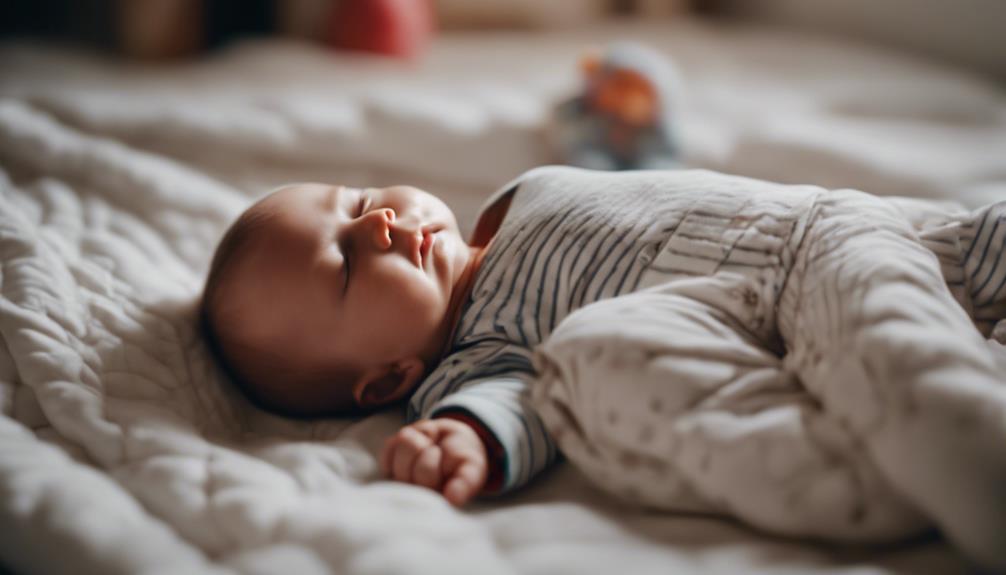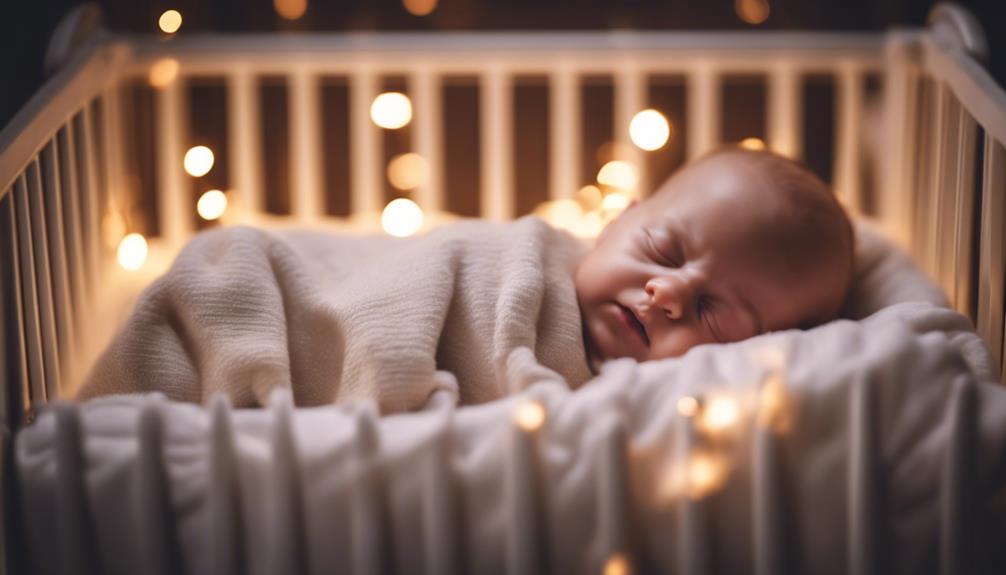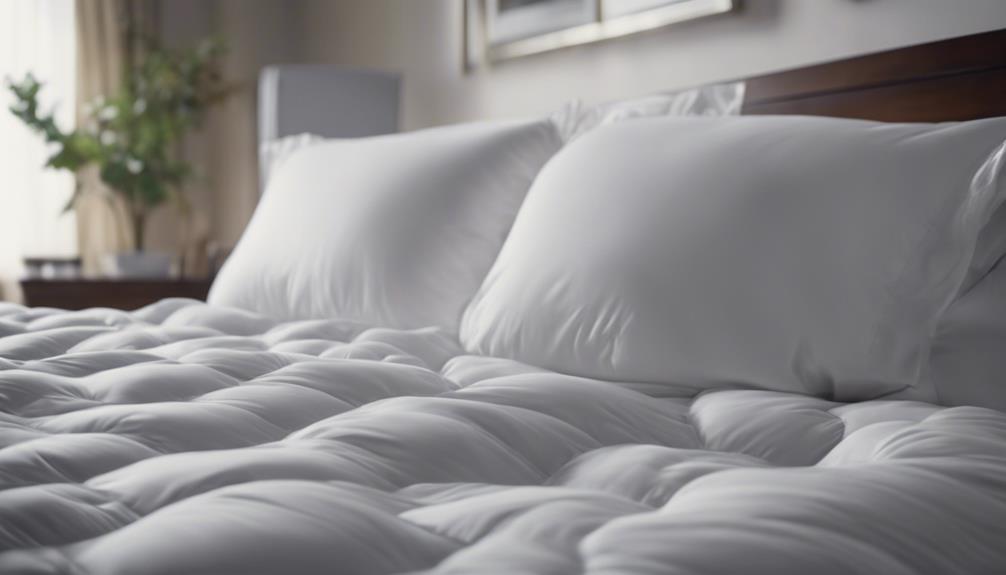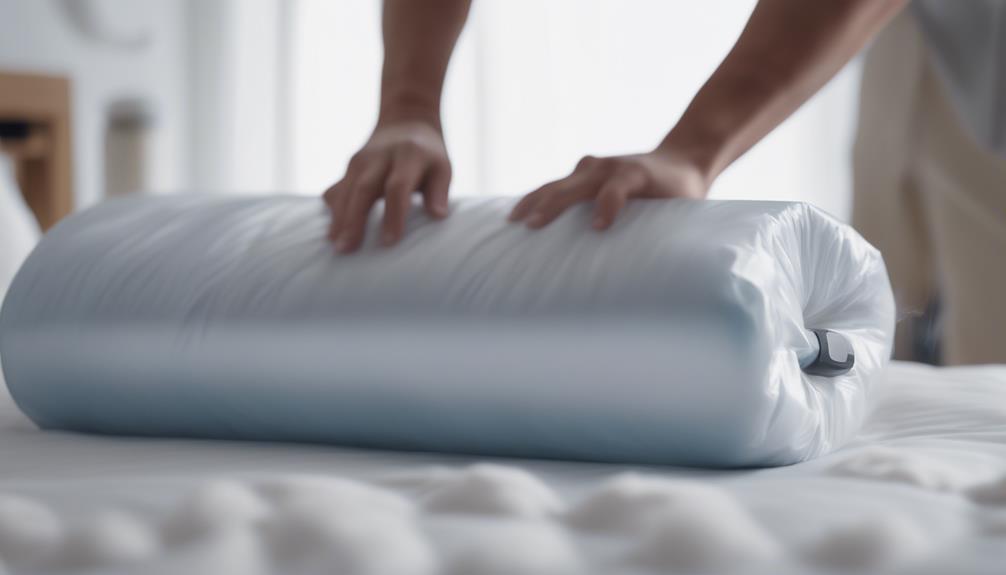When deciding if a baby can have a comforter, it is important to ensure that it follows safety guidelines. Opt for age-appropriate options with no choking hazards. Choose soft, washable fabrics and simple designs. Always supervise your baby when using the comforter during sleep to check for small parts or loose threads. Comforters can provide security and improve sleep patterns, which in turn aids emotional development and soothing. Introduce the comforter wisely during play or feeding times and gradually as your child grows. Learn valuable tips for comforter use and creating positive associations. By understanding these factors, you can create a safe sleeping environment for your baby.
Key Takeaways
- Introduce a soft, safe comforter for supervised sleep.
- Choose a breathable, hypoallergenic fabric comforter.
- Ensure comforter is free of choking hazards.
- Incorporate comforter into daily routines for familiarity.
- Follow safety guidelines and supervise baby with the comforter.
Safety Guidelines for Baby Comforters

When introducing comforters to babies, prioritizing safety is essential to prevent potential risks. Safe sleep practices are vital when it comes to selecting a comfort object for babies and toddlers. It's important to choose a comforter that's suitable for the child's age and development stage to avoid any choking hazards. Making certain that the comfort item is free of small parts, ties, or batteries can help maintain a safe sleep environment for the baby.
Supervising the use of comforters during the baby's sleep is recommended to prevent any accidents that may occur. Following safe sleep recommendations while introducing a comforter can help reduce the risk of suffocation or other sleep-related incidents. Staying informed about safe sleep practices in your region is also advised to ensure that the baby's sleeping environment remains safe and secure. By adhering to these safety guidelines, parents can create a safe and comfortable sleeping environment for their little ones.
Age-Appropriate Comforter Selection

When selecting comforters for babies, it's important to take into account safety aspects such as material and design. Opt for comforters made from soft, breathable fabrics that are hypoallergenic and free from small parts that could pose a choking hazard.
Additionally, choose comforters with simple, age-appropriate designs that are easy to wash and maintain for the baby's well-being.
Safety in Comforters
For safe comforter use with babies, opt for items made of breathable and washable fabric to minimize suffocation risks. When choosing a comforter for your baby, consider the following safety tips:
- Check for small parts, ties, or batteries that could pose a choking hazard.
- Select a lightweight and appropriately sized comforter to prevent entrapment or strangulation risks.
- Avoid comforters with loose threads or ribbons that may harm the baby.
- Always supervise the baby when using a comforter to guarantee safety during sleep or play.
Material and Design
Selecting a suitable comforter for a baby involves choosing a breathable, washable fabric that's free of small parts and potential suffocation risks. When considering materials and design, opt for something safe for babies, ensuring the comforter is washable and doesn't pose a suffocation risk.
Look for age-appropriate options without ribbons, ties, or heavy embellishments that could be hazardous. It's important to select a light and safe comforter that's securely attached to the cot bars to prevent any accidents.
Benefits of Comforters for Babies

Comforters for babies offer numerous benefits, such as providing a soothing sleep aid that promotes better sleep patterns.
They also offer a sense of security and comfort, helping little ones navigate through new situations with ease.
Introducing a breathable, washable comforter to your baby can assist in fostering healthy attachments and emotional development.
Soothing Sleep Aid
Babies greatly benefit from having a comforting sleep aid that provides emotional support and security during times of stress. Here are some key reasons why comforters are essential for babies:
- Emotional Soothing: Comforters offer a sense of security and comfort, helping babies feel calm and reassured during sleep and stressful situations.
- Attachment Development: Introducing a comforter around 7-9 months can assist babies in seeking reassurance and forming healthy attachments.
- Self-Soothing: Comforters aid in teaching babies how to self-soothe and manage their emotions, fostering independence and confidence.
- Sleep Support: Babies can use comforters to soothe themselves to sleep, navigate changes, and cope with separation anxiety effectively.
Security and Comfort
After exploring the significance of having a soothing sleep aid for babies, it becomes evident that the security and comfort provided by comforters play an essential role in their emotional development and well-being.
Comforters, often in the form of a soft toy, offer babies a sense of security, especially during times of separation anxiety. Contrary to indicating insecurity, attachment to a comforter supports self-soothing mechanisms, helping babies manage their emotions.
It's important to introduce a safe comfort item to babies, ensuring it's suitable for their age and free from potential hazards. By incorporating a comforter into playtime and bedtime routines, caregivers can assist babies in developing healthy attachments and finding comfort in times of stress or change.
Monitoring Devices for Comforter Use

To enhance safety when using comforters, caregivers may opt to utilize monitoring devices such as under-mattress sensors. These devices can provide added peace of mind by alerting caregivers if the baby shows signs of distress while using a comforter. Here are four ways monitoring devices can enhance comforter safety:
- Early Detection: Sensor mats can detect irregularities in the baby's breathing patterns, providing an early warning system for potential suffocation risks.
- Peace of Mind: Parents find reassurance in knowing that they've an extra layer of protection in place to monitor their baby's well-being while using a comforter.
- Customized Care: Monitoring devices allow caregivers to adjust sleeping arrangements based on the baby's movements, ensuring a safe and comfortable sleep environment.
- Parental Support: Addressing parental anxiety about comforter use by discussing concerns and implementing monitoring devices can promote better sleep associations and overall child health.
Online Communities and Comforter Tips

Engaging with online parenting communities can provide valuable insights and tips on safely introducing comforters to babies. When your baby reaches around 6-12 months old, you may consider introducing a comforter to help them self-soothe and feel secure when going to sleep. Online forums are rich with experiences shared by parents who have successfully incorporated comforters into their baby's sleep routine. These communities offer guidance on selecting safe and suitable comforters that meet your baby's needs. Discussions in these online platforms can also help alleviate parental anxiety surrounding comforter use, offering support and reassurance. Below is a table summarizing some key tips from online communities regarding introducing comforters to babies:
| Tips for Introducing Comforters |
|---|
| Wait until around 6-12 months old before introducing a comforter |
| Choose a comforter that is safe and suitable for your baby's age |
| Use the comforter as part of a calming bedtime routine |
| Be consistent in offering the comforter when your baby is going to sleep |
Ensuring Baby's Security With Comforters

Exploring how comforters can enhance a baby's sense of security and emotional well-being introduces valuable insights for parents seeking to support their child's development. When considering a comforter for your baby, it's crucial to prioritize their safety and well-being.
Here are some key points to guarantee your baby feels secure with their comforter:
- Introduce the comforter at the right time: Offering a comforter to your baby around 7-9 months of age can help them feel safe and secure.
- Encourage self-soothing: A comforter can assist babies in soothing themselves to sleep, promoting better rest and emotional management.
- Choose safe materials: Opt for breathable fabrics and avoid small parts that could pose a choking hazard to secure your baby's safety with the comforter.
- Support emotional development: Comforters play an important role in helping babies manage their emotions and seek reassurance during various developmental stages.
Practical Tips for Comforter Management

When introducing a comforter to your baby, it's essential to incorporate it into both playtime and bedtime routines to help them become familiar with it.
Choose a baby's comforter that's safe, without small parts, ties, or batteries. Make sure the comforter isn't too large or made of non-breathable fabrics.
During feeding times, introduce the comforter to create positive associations with comfort and security. When using the comforter for sleep, supervise your baby to prevent any risks.
Soft toys can also be introduced alongside the comforter to provide additional comfort and familiarity. Remember, the goal is to make the baby feel secure and soothed, so the comforter should be a calming presence.
Successful Introduction of Comforter to Baby

Introducing a cozy and safe comforter to your baby can greatly contribute to their sense of security and comfort. To guarantee a successful introduction, follow these steps:
- Familiar Scent: Sleep with the comforter yourself before giving it to your baby. This will help make the comfort item smell familiar and comforting to them.
- Incorporate into Routines: Integrate the comforter into various daily activities like feeding times, playtime, and bedtime routines. This will help establish a positive association with the comfort item.
- Supervised Sleep: Allow your baby to sleep with the comforter under supervision before they reach 7-12 months. This can aid in adapting to the comfort item during their sleep cycles.
- Observe and Set Boundaries: Pay attention to how your baby responds to the comforter. Set boundaries for its use and monitor their safe attachment to the comfort item to ensure its effectiveness in providing comfort and security.
Transitioning From Comforter in Toddlerhood

As children grow, their reliance on comfort items naturally diminishes, indicating a gradual shift away from the need for a comforter in toddlerhood. It is essential to understand that moving from a comforter is a normal part of a child's development. While some children may continue to use comfort items into early childhood, most will gradually decrease their dependence on them over time. This reduction in attachment to comfort items is a positive sign of emotional growth and independence.
To help you navigate this change, here is a table outlining some key points to keep in mind:
| Key Points | Description |
|---|---|
| Natural Process | Moving from a comforter is a natural part of a child's development. |
| Decrease in Dependence | Children tend to lessen their reliance on comfort items as they grow. |
| Outgrowing the Need | Children will naturally outgrow the need for a comforter as they develop coping skills. |
Frequently Asked Questions
At What Age Can Babies Have a Comforter?
Babies can have a comforter starting at around 6 months of age when they begin showing signs of independence. Introducing a comforter at this stage can assist with separation anxiety and provide comfort during bedtime.
It may also help soothe babies during stressful situations like immunizations or travel. Waiting until 6 months to introduce a comforter promotes safe sleep practices and encourages healthy attachment behaviors.
Do Babies Sleep Better With a Comforter?
We find that babies can indeed sleep better with a comforter. The familiar item can help them self-soothe and feel secure, potentially leading to improved sleep patterns.
Research indicates that comfort items like a soft toy or blanket can promote feelings of safety and relaxation, contributing to their emotional well-being during sleep.
Establishing a positive association with a comforter may also aid babies in smoother adjustments during changes or challenging situations.
Can a 1 Year Old Sleep With a Blanket?
Yes, a 1-year-old can sleep with a blanket, but it's best to introduce one after 18 months. Waiting helps reduce entanglement and suffocation risks during sleep.
Soft bedding, including comforters, should be avoided to minimize SIDS. For the safest sleep environment, use only a fitted sheet in the crib.
Waiting until at least 18 months before introducing a blanket promotes safer sleep practices and minimizes potential hazards.
What Bedding Is Safe for Babies?
When it comes to bedding for babies, safety is our top priority. A bare crib with just a fitted sheet is the best choice to reduce the risk of Sudden Infant Death Syndrome (SIDS) and suffocation.
Soft bedding like blankets should be introduced after 12-18 months to minimize entanglement risks. Remember, even when placed on top of the baby, soft bedding should be avoided to prevent suffocation and entrapment.
Conclusion
To sum up, introducing a comforter to your baby can provide a sense of security and comfort. By following safety guidelines, selecting age-appropriate comforters, and monitoring their use, you can guarantee a positive experience for your little one.
Remember to seek advice from online communities and follow practical tips for successful management. As your baby grows, consider moving away from the comforter in a gentle and gradual manner to support their development.









